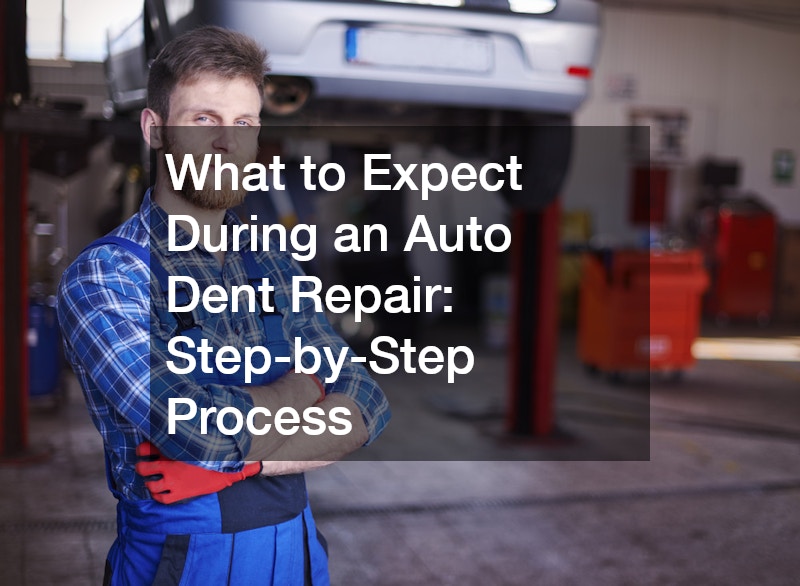Auto dent repair is one of the most common services car owners need at some point in their vehicle’s lifespan. Whether it’s from a minor fender bender, hail damage, or a careless parking incident, dents can detract from your vehicle’s appearance and, in some cases, affect its resale value. While it’s easy to overlook or dismiss the damage, getting it repaired promptly is often the best decision. Understanding the step-by-step process of auto dent repair can help you prepare and make informed choices. In this article, we’ll walk you through what to expect during auto dent repairs, whether it’s a quick paintless dent repair (PDR) or a more traditional approach.
What is the Initial Assessment in Dent Repair?
Before any repair work begins, the first step is to assess the damage. This process ensures that the repair shop accurately understands the severity and scope of the issue.
Initial Walkaround Inspection
The technician will start by walking around your vehicle to visually inspect the dents. They will look at the size, depth, and location of the damage to determine the best repair approach. This inspection helps in documenting the damage and getting a better sense of the work needed.
Quoting the Repair Cost
Once the technician has examined the vehicle, they will typically offer a quote for the repair. The cost depends on factors such as the dent’s size, location, and severity. For instance, a small dent on a non-structural area will likely cost less than a larger dent on a more complex surface. The technician may also factor in the time it will take to repair the dent.
Time Estimation
Technicians can usually provide an estimate of how long the repair will take. Simple PDR jobs might take only a few hours, while more intensive repairs, like those requiring bodywork and painting, can take a few days. Factors like the shop’s schedule and the complexity of the damage can influence the final time frame.
Damage Assessment Tools
To determine the extent of the damage, technicians may use specialized tools, such as light boards or depth gauges. These tools help assess how deep the dent is and whether it has caused any structural damage to the vehicle’s body. Accurate assessment is critical for determining the correct repair method.
Insurance Considerations
If you plan to use your insurance to cover the repair costs, the technician will often help with the process. Insurance companies typically require photos of the damage and an estimate before approving repairs. It’s important to ensure that the repair shop works directly with your insurance provider to avoid delays.
How is Paintless Dent Repair (PDR) Performed?
Paintless Dent Repair (PDR) is a technique that allows technicians to repair dents without having to repaint the vehicle. It’s an ideal solution for minor dents and dings that haven’t damaged the paint.
PDR Tools and Techniques
PDR requires specialized tools, including metal rods and body picks, which allow the technician to gently massage the back of the panel, pushing the dent back into shape. They may also use a light source to monitor the process, ensuring that the surface is perfectly restored.
Suitable Types of Dents for PDR
Not all dents are suitable for PDR. Small to medium-sized dents that haven’t cracked or damaged the paint are perfect candidates for PDR. However, larger dents, sharp creases, or dents located near body lines may not be repairable using this technique.
Steps in the PDR Process
Preparation: The technician cleans the damaged area and may remove interior panels for easier access to the back of the dent.
Dent Repair: Using the PDR tools, the technician carefully works from behind the panel, gradually massaging the dent until it’s level with the surrounding surface
Finishing: Once the dent is fixed, the technician inspects the area to ensure it’s smooth and even.
Advantages of PDR
PDR is a quicker, more affordable, and environmentally-friendly option since it doesn’t involve painting. The original paint job is preserved, which is ideal for maintaining the vehicle’s resale value.
Limitations of PDR
PDR is not suitable for all types of dents. If the paint is cracked, chipped, or if the dent is too deep, traditional methods may be necessary.
What is the Traditional Dent Repair Process?
For larger or more severe dents that can’t be repaired with PDR, traditional methods are used. These processes involve more intensive work and may require repainting.
Disassembly and Accessing the Dent
Technicians first remove any trim, panels, or interior parts blocking access to the dent. This disassembly allows them to get a better angle to repair the damage.

Auto dent repairs, whether through paintless dent repair or traditional methods, is a straightforward process that can restore your car’s appearance and value. By understanding the steps involved and choosing a reputable repair shop, you can ensure your vehicle is in good hands. Maintaining your car post-repair is essential to keeping it in excellent condition and preventing further damage.
